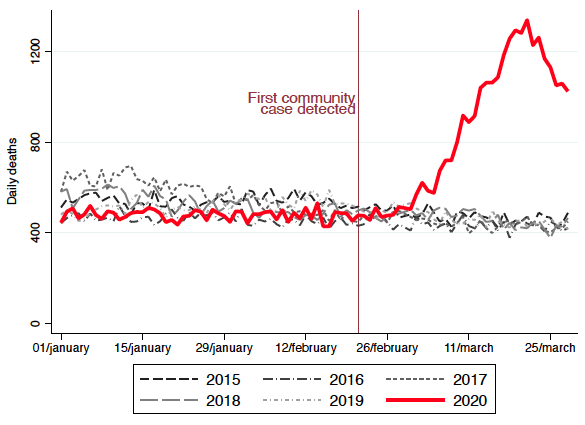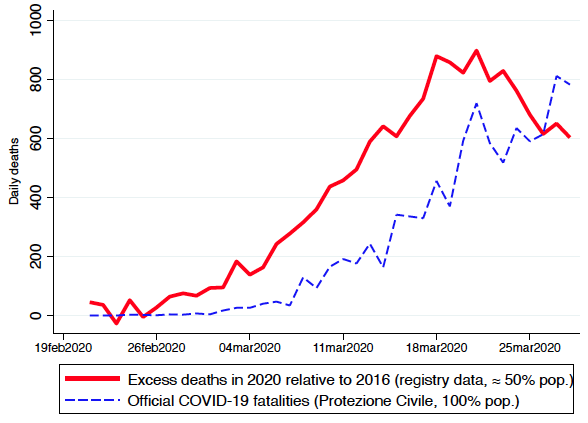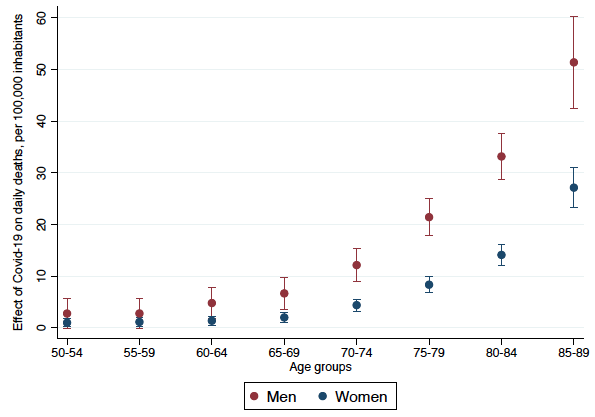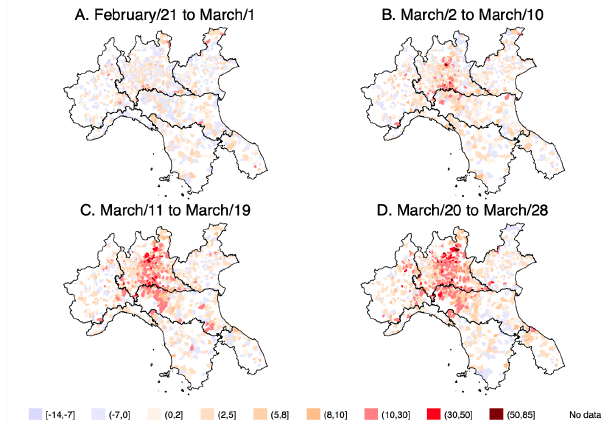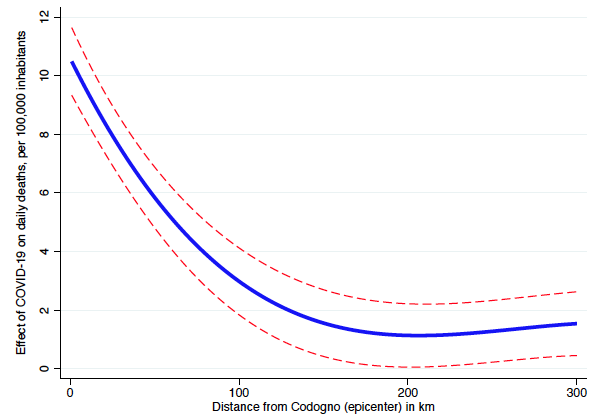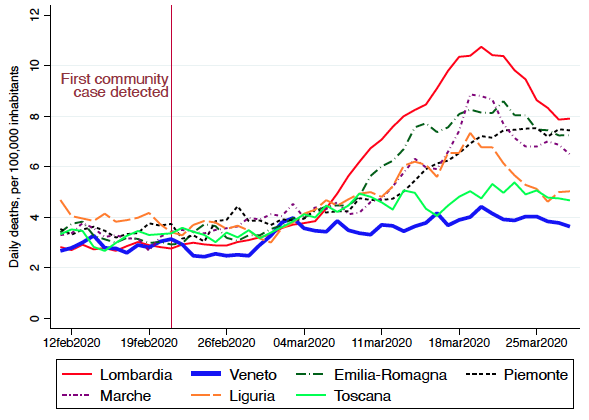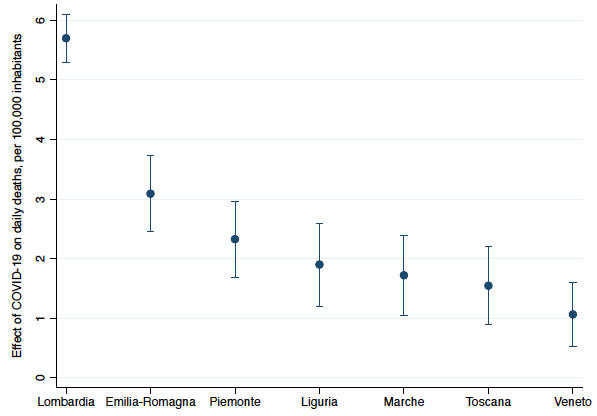There are still many unknowns about COVID-19. We don’t know its true mortality rate, nor the speed through which it spreads across communities. This lack of evidence complicates the design of appropriate response policies. The case of the UK is illustrative. The government first opted for the bare minimum in terms of mitigation. It then drastically reversed course after micro-simulations by the Imperial College COVID-19 Response Team showed that that strategy could have resulted in hundreds of thousands of deaths (Ferguson et al. 2020).
In a new paper (Ciminelli and Garcia-Mandicó 2020), we source daily death registry data for a sample of 1,161 Italian municipalities in the seven regions most severely hit by COVID-19 (Emilia-Romagna, Liguria, Lombardia, Marche, Piemonte, Toscana, and Veneto) and match them to census data to analyse COVID-19-induced mortality. Overall, the dataset covers a population of almost 15 million inhabitants, roughly 25% of Italy’s total.1
Daily deaths almost tripled in the 30 days following outbreak detection
Figure 1 compares the number of deaths in 2020 (red line) against each of the five preceding years. Soon after the detection of the first COVID-19 community case (21 February), daily deaths increased rapidly. In less than four weeks, they almost tripled from 477 on 21 February to 1,338 on 21 March.
Figure 1 Daily deaths in 2020 compared to the five preceding years
Source: authors’ own calculations from ISTAT daily death registry data
COVID-19 might have killed about 0.1% of the local population in less than 40 days
Deaths before the COVID-19 outbreak were following fairly closely deaths in 2016. Assuming that this trend would have otherwise continued, we estimate that COVID-19 might have contributed to the death of more than 15,000 people – about 0.1% of the local population – between 21 February and 28 March 2020 (the last day covered in the dataset). Around its peak on 21 March, the daily death rate was just under 10 per 100,000 inhabitants.
In their simulations for the UK, Ferguson et al. (2020) predicted that, in the absence of any government intervention and behavioural changes in the population, COVID-19 would result in 10 deaths per 100,000 inhabitants per day by early May 2020. A direct comparison with the UK is difficult. However, our finding that the grim threshold of 10 deaths per day per 100,000 inhabitants was reached in just over a month in our sample of Italian municipalities – despite some government intervention (see below) – might suggest that the true mortality of COVID-19 is higher than currently assumed.
Countrywide lockdown works
The Italian government changed course in the management of the outbreak as this unfolded. On 23 Februrary, it quarantined a narrow area of 10 municipalities around Codogno, a small town in Lombardia where the first community case was detected, as well as one municipality in Veneto. As COVID-19 continued to spread, the government gradually introduced new restrictions in the areas in proximity to the epicentre, before imposing a complete lockdown of the entire region of Lombardia and fourteen other provinces in Emilia-Romagna, Marche, Piemonte and Veneto, on 8 March. On 11 March, the lockdown was extended throughout Italy.
Daily deaths peaked on 21 March (Figure 1), exactly two weeks into the lockdown of Lombardia and some provinces in other regions. Considering an incubation time of five days on average, and a lag in the development of the most serious symptoms (Hartl et al. 2020), the countrywide lockdown seems to have worked fairly well in reducing contagion, and – with a lag – mortality. With insights, the government could have imposed it earlier to limit the extent of the epidemic.
The scale of the epidemic is vastly underreported in official statistics
We compare death registry data with official COVID-19 fatality data from Protezione Civile (2020). Since official data are only available at the regional level, we use data for the seven regions covered in our study. These track COVID-19 fatalities for the entire sample of municipalities in each region, while our death registry data only cover a subsample of municipalities, together representing less than half of the population of the seven regions.
Figure 2 compares the official daily number of COVID-19 fatalities (dashed blue line) with the excess deaths in 2020 relative 2016, as recorded in municipal death registry data (solid red line). Excess deaths were higher than official fatalities throughout the period, except for the last two days. That is striking as death registry data are only available for about half of the population while official death data refer to the entire population, and it suggests that deaths attributable to COVID-19 might have been vastly underreported in official statistics.
What is the scale of underreporting? The difference between excess deaths and official fatalities gives us a lower bound – at a minimum, true deaths were about two thirds larger than what reported in official statistics. But since death registry data cover less than 50% of the population of the regions in the sample, underreporting is likely to be larger. A back-of-the-envelope calculation suggests that true deaths induced by COVID-19 might be about twice as high as officially reported.2
Figure 2 Excess daily deaths in 2020 relative to 2016 versus official COVID-19 fatalities
Source: authors’ own calculations from ISTAT daily death registry data and Protezione Civile (2020)
What can explain this underreporting? In Italy, guidelines for the classification of COVID-19 fatalities vary by regions, but in most cases deaths outside hospitals are not counted in official statistics. Anecdotical evidence suggests that, as the health system struggled with a surge in demand, many old patients died of COVID-19 at home or in elderly care facilities (Reuters 2020).3 Limited testing capacity might have been a complementary reason. While deaths from registry data peaked on 21 March, official COVID-19 fatalities peaked later, around 27 March, suggesting that the authorities might have progressively improved testing capability. In that case, the extent of underreporting has likely decreased over time.
Mortality increases exponentially with age, and men are most affected
Figure 3 reports the estimated effects of COVID-19 on average daily deaths per 100,000 inhabitants, separately for men and women, and across different age groups. Effects for individuals below 50 years of age are not reported, as these are not statistically significant.
Figure 3 Effect of COVID-19 on daily deaths per 100,000 people, across gender and age
Notes: dots denote point estimates from regression analyses, spikes are 90% confidence intervals.
Source: authors’ own calculations from ISTAT death registry and census data.
Mortality increases exponentially with age, but at much higher levels for men: the effects of COVID-19 for men are three times those for women. These results confirm that gender differences play a crucial role in understanding the distribution of risk from the epidemic (Wenham et al. 2020). Further work is needed to pin down the origin of these differences, to shape better responses to the epidemic.
Relatively few municipalities account for an outsized number of deaths
Data presented so far were aggregate for the entire sample of the 1,161 municipalities covered in the dataset. Figure 4 uncovers variation in the spread of the epidemic both across different municipalities and across space. We assign different colours to municipalities, based on the change in the death rate in 2020 relative to 2016. Negative changes are denoted with blue, increases between zero and ten daily deaths per 100,000 inhabitants are marked by different shades of orange. Municipalities experiencing large increases in daily deaths (above 10 per 100,000 inhabitants) are denoted by red colours.
Figure 4 Map of excess deaths in 2020 relative to 2016, by municipality
Notes: the figure shows municipal-level variation in daily excess deaths per 100,000 inhabitants in 2020 relative to 2016
Source: authors own calculations from ISTAT death registry and census data
At the start of the epidemic, excess deaths were generally low, except for a few municipalities. By the beginning of March, two large outbreaks in the Lombardia region had become apparent, one in the south, around the town of Codogno (the epicentre), and another in the north, around Alzano Lombardo (a town close to Bergamo). While deaths increased across most municipalities during the unfolding of the outbreak, the increase around these two clusters was much higher. Along the border between Lombardia and neighbouring regions, death rates were high in both Emilia-Romagna and Piemonte, while they were not in Veneto.
Decreasing effects the further from an epicentre, but only up to a point
We analyse how the impact of COVID-19 varies with distance to Codogno, where Italy’s first case of community transmission was recorded. Figure 5 summarises the effect of COVID-19 on daily deaths per 100,000 inhabitants, by distance from Codogno. COVID-19 has very large effects in municipalities that are in proximity to the epicentre: mortality increased by an average of over 10 deaths per day for every 100,000 inhabitants. As the distance from the epicentre increases, the impact of the outbreak diminished. For municipalities located 100 km from Codogno, the effect of the outbreak is around 3 daily deaths per 100,000 inhabitants. The effect converges to slightly above one death at the 150 km mark and remains constant as distance increases.
Figure 5 Effect on daily deaths per 100,000 inhabitants, by distance from epicentre
Notes: estimates from Equation (2). The blue solid line denotes point estimates from regression analyses, red dashed lines are 90% confidence bands. Source: authors’ own estimation based on ISTAT death registry and census data
Municipalities that are closer to the epicentre thus seem to have been hit harder than those that are further away. This is despite the fact that the entire area of 10 municipalities around Codogno was immediately quarantined after the first case was detected, and it suggests that the virus had already spread to neighbouring areas by then.
The low effect of the epidemic on mortality in municipalities farther away from the epicentre could be because their outbreaks have started later. If this were to be the case, the differences in distance from the epicentre should disappear once the full-blown effects of the epidemic materialise. Another, not exclusive, possibility is that hospitals in municipalities close to the epicentre were unprepared to deal with the outbreak because it was unexpected, while hospitals in other areas learnt from the experience in Codogno and were more prepared to handle the virus.
Mass testing, at-home care provision and contact tracing: The Veneto Model
The Veneto region has been widely praised for its timely and proactive response to the pandemic. Much has been written about the ‘Veneto Model’ (Cedrone 2020, Zanini 2020, Zingales 2020), and we only summarize its main characteristics: (1) mass testing, including testing of mildly symptomatic cases; (2) at-home testing and care provision; and (3) tracing and quarantining contacts. Both ramping up the testing capacity and developing a comprehensive tracking system have been recognized as essential elements to coping with the epidemic (Baldwin 2020, Panizza 2020). Testing and providing care at home works towards preventing the spread of the virus.
Figure 6 plots mortality rates by region. While before COVID-19 mortality was comparable across regions, differences become apparent soon after its onset. In Lombardia, mortality steeply increased and peaked at well over 10 deaths per day for every 100,000 inhabitants – an almost four-fold increase compared to pre-Covid-19 levels. At the other end of the spectrum, deaths per capita remained fairly low and stable in Veneto.4
Figure 6 Daily deaths per 100,000 inhabitants, by region
Source: authors’ own calculations based on ISTAT death registry and census data
COVID-19 induced mortality in Veneto is six times lower than in Lombardia
Figure 7 shows the estimated effect of COVID-19 on mortality rates for each region.
Figure 7 Effect on daily deaths per 100,000 inhabitants, by region5
Notes: dots denote point estimates from regression analyses, spikes are 90% confidence intervals.
Source: authors’ own estimation based on ISTAT death registry and census data
The pandemic resulted in almost 6 more deaths per 100,000 inhabitants per day in Lombardia, on average. The effect is significantly smaller in all the remaining six regions. Across the three regions bordering Lombardia, we estimate a very low effect on mortality rate in Veneto, at around 1 daily death for each 100,000 inhabitants. This is significantly less than both Emilia-Romagna and Piemonte and provides useful lessons for policymakers around the world on how to manage new outbreaks of COVID-19 in the future.
Authors’ note: The views expressed in this column are those of the authors and do not represent those of the OECD or its member countries.
References
Baldwin, R (2020), “COVID-19 testing for testing times: Fostering economic recovery and preparing for the second wave,” VoxEU.org, 26 March.
Ciminelli, G, and S Garcia-Mandicó (2020), “COVID-19 in Italy: an Analysis of Death Registry Data,” mimeo.
Cedrone, G (2020), “Scovare i positivi casa per casa: così abbiamo sconfitto il virus a Vo’. Il virologo Crisanti racconta il modello Veneto”, Sanità e Informazione, 12 March.
Ferguson, N M et al. (2020), “Impact of Non-pharmaceutical Interventions (NPIs) to Reduce COVID- 19 Mortality and Healthcare Demand”, Imperial College.
Hartl, T, K Wälde, and E Weber (2020), “Measuring the impact of the German public shutdown on the spread of COVID-19,” Covid Economics: Vetted and Real-Time Papers 1.
ISTAT “Decessi del 2020,” database (accessed 12 April).
ISTAT “Indicatori Demografici,” database (accessed 12 April).
ISTAT “Territorio e Cartografia,” database (accessed 12 April).
Panizza, U (2020), “Europe is Ground Zero”, Chapter 17 in R Baldwin and B Weder di Mauro (eds), Mitigating the COVID economic crisis: Act fast and do whatever it takes, a VoxEU.org eBook, CEPR Press.
Protezione Civile (2020): “Bollettino Emergenza Coronavirus,” 12 April.
Reuters (2020), “Death at home: the unseen toll of Italy’s coronavirus crisis”, Reuters World News, 4 April.
Economist (2020), “Deaths from cardiac arrest have surged in New York City”, 13 April.
Wenham, C, J Smith, and R Morgan (2020), "COVID-19: the gendered impacts of the outbreak", The Lancet 395(10227): 846-848.
Zanini, M (2020): “Managing the pandemic: lessons from Italy’s Veneto region”, Medium.com, 27 March.
Zingales, L (2020), “Why mass testing is crucial: the US should study the Veneto model to fight COVID-19,” Pro Market Blog, 17 March.
Endnotes
1 Death registry data are taken from ISTAT, the Italian Statistical Agency, and provide information on daily deaths by gender and age in 1,450 Italian municipalities, for the 1 January to 28 March period, for the years 2015 to 2020. The municipalities covered are a subset of a sample of Italian municipalities that reported to the national registry of the resident population (Anagrafe Nazionale della Popolazione Residente, ANPR), as of 31 December 2019. From this sample, ISTAT selected a subset of municipalities that (i) have experienced an increase in mortality of at least 20% in 2020 relative to the average of the five preceding years, and (ii) are deemed to have provided accurate information. From this sample of 1,450 municipalities, we focus on those in the seven regions for which at least 20% of the population is covered. These are also the regions most severely hit by COVID-19. Overall, our dataset covers 1,161 municipalities. Census data also come from ISTAT and provide population numbers by age and gender of the resident population, as of 1 January, for the years 2015 to 2019. We impute population data for 2020 by using 2019 growth rates.
2 Italian municipalities can be divided in two broad categories, depending on whether or not they report to the national registry of the resident population (ANPR). We only observe a selection of the municipalities that do report to the ANPR, and this selection is likely associated with a higher incidence of COVID-19, as only municipalities that (i) have experienced an increase in mortality of at least 20% in 2020 relative to the average of the five preceding years, and (ii) are deemed to have provided accurate information are included (see Footnote 1). We assume that COVID-19 did not lead to any increase in mortality in those municipalities that do report to ANPR but are not included in our data. For non-reporting municipalities, we instead assume that the share of the population living in municipalities that experienced a mortality higher than 20% in 2020 relative to previous years is the same as the share of the population living in municipalities reporting to ANPR that did experience such increase. We further assume that, among the population living in non-reporting municipalities with mortality higher than 2020, the per capita excess mortality rate in 2020 relative to 2016 is the same as observed in the municipalities in our sample. We then add the number of excess deaths observed in the sample to our estimate of likely excess deaths in the municipalities that do not report to ANPR to obtain a plausible number (19,537) of total excess deaths in the seven regions considered in our study. We then compare this number to official COVID-19 fatality data and conclude that, up to 28 March, true deaths might have been 96% higher than what reported. Note that this might be a conservative estimate, since we assumed no COVID-19-induced mortality among municipalities that do report to ANPR but that are not covered in our sample, but it gives a plausible lower bound of underreporting.
3 Similar evidence of underreporting is surfacing across several countries. As an example, we refer to an article from The Economist (2020) about under-counting of COVID-19 deaths in New York City.
4 In Emilia-Romagna, Marche and Liguria, mortality trends are similar to that in Lombardia, however at a significantly lower level. In Piemonte, possibly because the thick of the crisis started a few days after, we do not yet observe a reversal to the increase in mortality. In Toscana, mortality increased considerably less than in the other regions, possibly because it is far from the epicentre.
5 We empirically estimate the effect of COVID-19 on daily mortality rates using 2016 mortality trends for each of the Northern regions in a differences-in-differences approach, to control for region-specific time invariant factors and seasonality.

